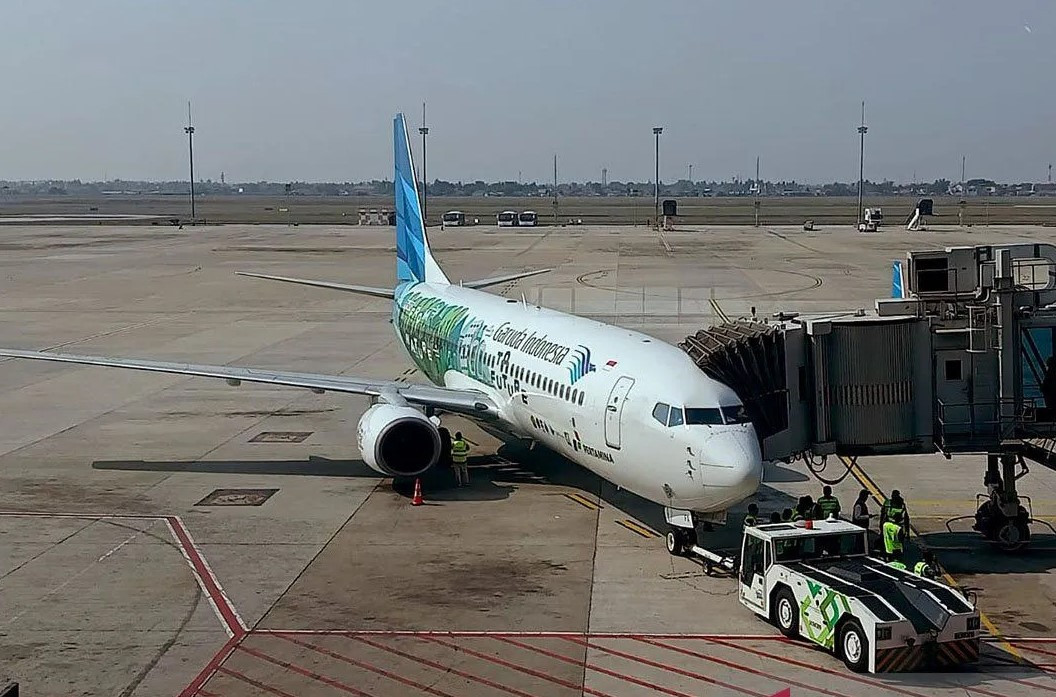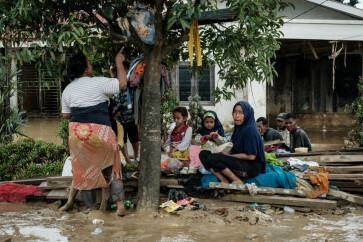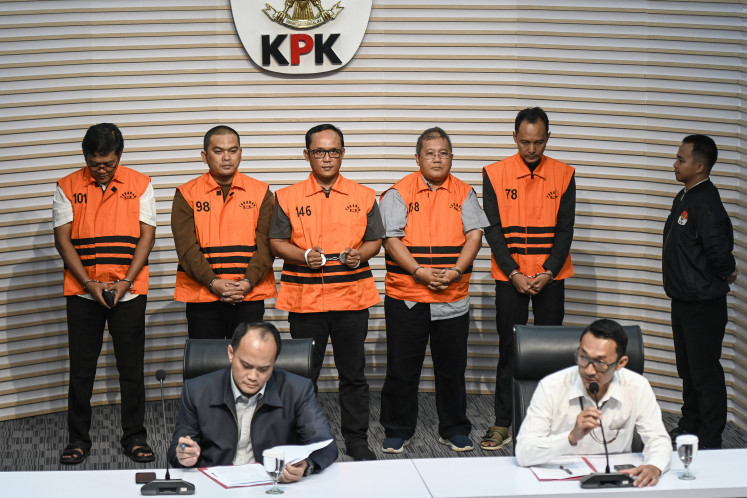Popular Reads
Top Results
Can't find what you're looking for?
View all search resultsPopular Reads
Top Results
Can't find what you're looking for?
View all search resultsWhy Indonesia should care about sustainable aviation fuel
Without any intervention, the aviation industry is estimated to triple CO2 emissions by 2060 compared to pre-pandemic levels.
Change text size
Gift Premium Articles
to Anyone
 Green flight: Technicians prepare a Garuda Indonesia plane for a test flight using sustainable aviation fuel on Oct. 27, 2023, at Soekarno-Hatta International Airport in Tangerang, Banten. The plane successfully landed in Adi Sumarmo Airport in Surakarta, Central Java, later that day.
(Antara/Farhan Arda Nugraha)
Green flight: Technicians prepare a Garuda Indonesia plane for a test flight using sustainable aviation fuel on Oct. 27, 2023, at Soekarno-Hatta International Airport in Tangerang, Banten. The plane successfully landed in Adi Sumarmo Airport in Surakarta, Central Java, later that day.
(Antara/Farhan Arda Nugraha)
A
viation has revolutionized the way we travel and transport goods, connecting the farthest reaches of Indonesia in hours instead of days. But with air travel set to surge in Indonesia, alongside the growth of the middle class, how can the country mitigate the negative impacts of rising emissions from air travel?
Should Indonesia – the world's largest archipelagic nation – sacrifice air travel for the climate? The answer lies in sustainable aviation fuel (SAF).
SAF may sound like another buzzword in the aviation world, but it is a game changer. Unlike conventional fossil-based jet fuel, SAF is produced from renewable sources such as palm oil, sugar cane and even wastes like used cooking oil and municipal solid waste.
SAF itself is not a novel concept. After its initial development in the early 2000s and undergoing its maiden flight test in 2008, the new fuel’s potential is only now staring to being explored.
Despite its diverse array of feedstock, SAF matches the safety standards of conventional jet fuel. Rigorous testing and global standardization have ensured that SAF is not only safe but also fully compatible with existing jet engines and fuel infrastructure, requiring no modifications.
According to the International Air Transport Association (IATA), SAF can reduce carbon emission by up to 80 percent over its lifecycle compared to conventional jet fuel. Hence, the carbon reduction potential for SAF is profound, and SAF is expected to become the biggest contributor in helping the global aviation industry achieve net zero emissions by 2050.
A sustainable aviation industry is paramount as air travel in Indonesia continues to expand, projected to become the fourth largest aviation market globally in the coming decades. Without intervention, the national aviation industry is estimated to triple CO2 emissions by 2060 from pre-pandemic levels.
Utilizing SAF made from used cooking oil, Indonesia could reduce 84 percent of CO2 emissions compared to conventional jet fuel, potentially amounting to 20.9 gigatonnes of CO2 abatement by 2060.
The benefits of SAF also go beyond climate, as it can help Indonesia achieve energy sovereignty. Indonesia is blessed with various feedstock which make up the raw material of SAF. This is clearly an asset for the country to secure its energy needs.
For example, Indonesia is one of the top three global exporters of used cooking oil (UCO), exporting around 227 kilotonnes in 2022, or 95 percent of its collected amount. These UCOs are mostly exported to SAF producer countries such as Singapore, Spain and the Netherlands as production feedstock.
Indonesia could reduce its reliance on imports to fuel the domestic aviation industry if UCOs are retained domestically for SAF production. Therefore, developing a domestic SAF industry could help Indonesia achieve energy sovereignty.
Additionally, SAF offers an immense economic potential for Indonesia. As the global pursuit for sustainable aviation intensifies, the demand for SAF is expected to take off, reaching 35 million tonnes annually by 2030, while production capacity is anticipated to be 18.3 million tonnes annually. This demand-supply gap presents a unique opportunity for Indonesia, given that we have an abundance of feedstock for SAF production and a healthy investment climate for biofuel refineries.
Indonesia's recent success in completing its first commercial flight test using SAF conducted by Pertamina and Garuda Indonesia demonstrates the country's readiness to boost domestic investment in biofuel refineries, with Pertamina alone investing in two facilities in Cilacap and Plaju – potentially generating close to US$ 2 billion per year in SAF revenue at current prices.
As the SAF market matures, Indonesia is ready to become a hub for SAF production, welcoming further investments from both private sector developers and state-owned enterprises (SOEs).
Indonesia is blessed by abundant resources and the market potential to become the rightful leader of the regional SAF industry. With abundant feedstocks sufficient to meet domestic and regional demand, and as the largest aviation market in Southeast Asia, Indonesia can leverage these potentials to incubate SAF development and set the trajectory for the region.
We must act now to secure Indonesia’s rightful place as the regional SAF industry leader. Other countries in the region have taken steps forward in developing the SAF industries and aspire to become major hubs for SAF, despite relying heavily on Indonesia’s feedstock.
Without the right initiatives to compete and develop the domestic industry, Indonesia risks losing its competitive edge and allowing its resources to benefit other nations.
The good news is that the Office of the Coordinating Maritime Affairs and Investment Minister, in collaboration with public and private stakeholders, is formulating an industrial road map and policy to unlock Indonesia’s potential in the SAF industry, with the goal of positioning Indonesia as the regional SAF industry leader. The SAF strategy will be part of Indonesia’s broader ambition to become the world’s green energy powerhouse as part of the Golden Indonesia 2045 vision.
Support and collaborative efforts of all stakeholders are key to ensuring the success of this road map and policy. This landmark initiative for Indonesia’s aviation industry will drive sustainable growth and provide a greener future to all.
***
The writer is the deputy to the coordinating maritime affairs and investment minister for maritime and energy sovereignty and has been facilitating the development of aviation biofuel industrial policy in Indonesia.










